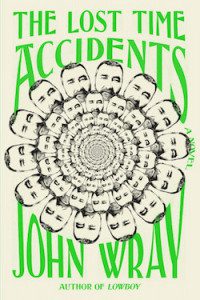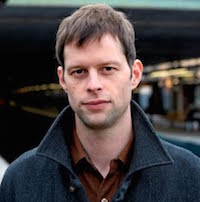
The past, Kaspar reasoned, is most accurately conceived of as a continent we’ve emigrated from, or better still as a kind of archipelago: a series of nearly contiguous islands, self-contained and autonomous, that we’re constantly in the process of forsaking, simply by advancing through time. Like all things past, his wife existed in a zone of the continuum that was inaccessible to him now. This by no means meant that she no longer was.
The protagonist of John Wray’s relentlessly engaging new novel, The Lost Time Accidents, traverses the line between brilliance and madness, a locus consistent with that of Wray’s previous work, Lowboy. Like Billy Pilgrim of Vonnegut’s Slaughterhouse-Five or James Cole, hero of Terry Gilliam’s 12 Monkeys, Waldimar Tolliver II (known as “Waldy”) grapples with a sublimely liminal experience at the brink of chronologic time, and of sanity.
Were the tension between eccentric genius and mental illness the novel’s fulcrum, Wray would have been hard put to escape cliché, but this dialectic is at most a refrain throughout. Within the world of the novel, Waldy’s experience in the margins of timespace remains irrefutable. The protagonist is writing the story of his family curse from a way station outside of time but anchored in space—specifically his aunts’ apartment in Harlem. Wray frames the text as an artifact emerging from this timeless space. If Waldy’s manuscript is the fruits of madness, then the reader, like the text’s metafictional author, is too far gone to care, free to navigate the story on its own terms.
Waldy’s imagined voyage into his family’s past breathes life into history. Wray deserves much credit for his transporting descriptions of Znojmo, Moravia, and prewar Vienna, which render the cities in four dimensions and full emotional color. As the story progresses, we discover that Waldy’s namesake was a war criminal, known as “The Black Timekeeper of Czas,” who experimented on prisoners, mostly Jews, in a death camp called Ӓschenwald in eastern Poland. Waldy’s struggle to come to terms with this forebear defines his unsettling arc.
The Lost Time Accidents could be read as a stifled bildungsroman, a response to Mann’s The Magic Mountain in which the Tolliver family curse—an obsession with a missing theorem—equates to a refusal to come of age and conform to “consensus reality.” The curse is nothing but the germ of an idea, a mysterious code about the nature of time that each successive generation of physicists aims to crack. But the curse of the Accidents behaves like a genetically transmitted disease, reducing each infected family member to a life of labor in obscurity, or of fame as a religious icon. Recognition within the scientific community remains wholly out of reach for the Toulas, then the American Tollivers, who find themselves increasingly isolated, unwilling or unable to escape the family curse.
Although the narrator’s witticisms and wry overtones lend it a comedic edge, at its heart, Wray’s novel is a tragedy. It is a book about loss, nostalgia, failure, and complicity in the horrors of history. A poignant question rests at its core: May we go back, to those moments before it all went to seed?

The Tolliver family’s notion of rotary time, a variation on relativity, contends that we might. But although the arrow of time moves both ways in this universe, the chronospheric traveler cannot move forward while experiencing either the past or Waldy’s purgatorial way station. Wray’s characters may travel through time, in other words, but so long as they choose to do so, the past rules them.
The Lost Time Accidents is highly entertaining and infinitely accessible. Structurally, the novel uses a frame narrative to contain several threads of Tolliver family history. The epistolary nature of Waldy’s text adds a dimension of forward movement to the frame narrative as Waldy discovers secrets of the Tolliver family tree.
The novel loses a bit of steam toward the end of its second act, partly as a result of the frame’s backward movement into Waldy’s memory, but the story provides ample motivation for such a turn when Waldy’s namesake, the war criminal, invades his aunts’ apartment and challenges Waldy to remember how he arrived there. As structural gambits go, the payoff of this backward look merits the risk, creating a sense of inevitability at the denouement. The frame warps and wends toward its own beginning like a Möbius strip, a form wholly in line with the text’s function.
Many literary readers will find this novel’s bold vision a refreshing stroke, but science fiction readers may prove harder to impress. The novel rests on a combination of science, history, pseudoscience, and speculation, not the stuff of hard SF. But, as one character notes, it’s the questions behind the Accidents, not the math, that ultimately distinguish the family curse. Readers who value the genre’s use of the imagination to ask “what if?”—fans of H. G. Wells and Douglas Adams, for example—might appreciate Wray’s novel, not least for the vein of humor that runs through it.
But another vein running through The Lost Time Accidents stands to trouble the speculative fiction reader. Through his characters’ exploits, such as Waldy’s father’s career as a purveyor of “smut” or “pulp”—which is to say, science fiction, albeit of a certain stripe—Wray struggles with the legacy of genre. This paternal character, named Orson Scott Tolliver (a twist of the surname away from one of science fiction’s more bigoted figureheads) writes an opus about rotary time that sparks a new religion: a cult that begs comparison to Scientology. Another character, or caricature, central to the mysteries of the Accidents is a Nazi sympathizer named Menügayan whose dialect, while admittedly entertaining, strays well into satire of a certain fannish type.
Amusing though it may be, this tableau remains less than flattering. One can’t help but note that Wray has written a science fiction novel that lampoons science fiction. Self-effacing though this gesture may be, it can also be read as an attempt to keep The Lost Time Accidents outside of the genre ghetto in terms of its critical reception, while still attracting science fiction readers when it comes to sales. The text exhibits a desire to ally itself with science fiction but also to refute it—to capitulate, perhaps, to the upmarket notion that all genre fiction deserves a thorough ribbing.
Virginia Woolf’s writings on gender in A Room of One’s Own can help trace these symptoms back to the societal pressures that produce such stratified reflections of genre:
One has only to skim those old forgotten novels and listen to the tone of voice in which they are written to divine that the writer was meeting criticism; she was saying this by way of aggression, or that by way of conciliation. She was admitting that she was ‘only a woman’, or protesting that she was ‘as good as a man’. She met that criticism as her temperament dictated, with docility and diffidence, or with anger and emphasis. It does not matter which it was; she was thinking of something other than the thing itself. Down comes her book upon our heads. There was a flaw in the centre of it.
If one replaces “woman” with “science fiction writer,” “man” with “literary writer,” and “the thing itself” with “the heart of this work,” Woolf’s passage applies to John Wray’s The Lost Time Accidents quite aptly. It would be a stronger book if it embraced its genre more and satirized it somewhat less, foregrounding the important questions at its core.




